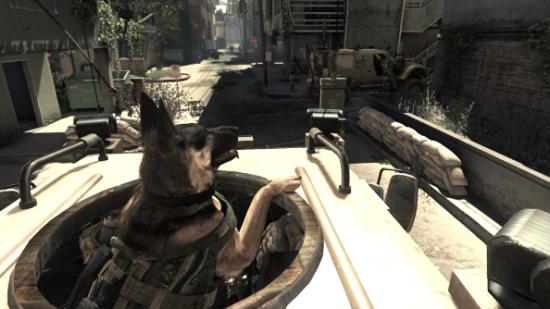Call of Duty: Ghosts has an early scene where a German Shepherd looks like he’s driving a jeep. That’s pretty much the best bit. The rest of it is just loud. An unrelenting stream of explosive set pieces, shouty men and gunfire, playing it is like peering into the broken, vacuous mind of Michael Bay.
Like the works of the action auteur, it manages to make collapsing buildings and falling from great heights incredibly mundane.
Ghosts epitomises, perfectly, the inescapable problems inherent in annual franchises and stands as the weakest Call of Duty game in the series’ decade run. It’s a checklist, with Infinity Ward and Co. simply ticking the boxes to ensure that it’s just like every other installment, minus the occasional bright sparks that set them apart. There’s the snow level, the desert level, the stealth level, the bit where a playable character dies and 1,562 scripted explosions.
Someone at Infinity Ward has good ideas stirring in their noggin. I know this, because the set up for the tenth core game in the series is actually compelling. The great conqueror America is on the back foot, pounded into submission by a huge enemy force that snatched up the planet’s dwindling energy supply.
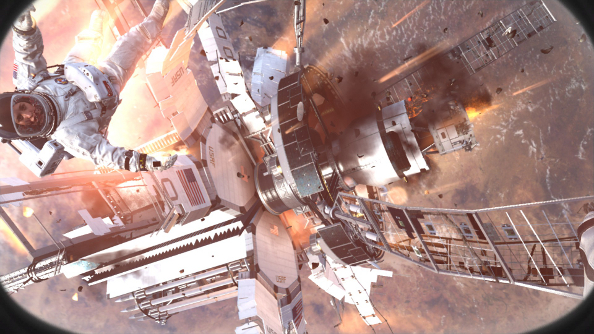
The premise, lamentably, does not inform the design. Instead of making the eponymous Ghosts – a squad of elite soldiers – rugged, exhausted survivalists who use guerilla tactics to deal with a larger, more advanced force, the protagonist and his chums are forced into the same dance we’ve seen countless times before.
The Ghosts have all the latest toys: remote snipers, dog cameras, strobe lights on their guns, tanks, helicopters, aircraft carriers, and everything else you might expect from a near future fighting force with limitless resources. After slaughtering wave after wave of enemies with giant targets on their backs on land, sea and even in space with the greatest of ease there’s a complete absence of tension or threat. These are aggressive super soldiers who can do whatever they want.
And despite my earlier compliments towards the premise, I’m not suggesting that it isn’t problematic either. The “big bad” of Call of Duty: Ghosts isn’t Russia or a Middle Eastern terrorist group – this time Infinity Ward has set its sights on evil South America, specifically the fictional “Federation”, an amalgam of South American nations that have taken over the world, somehow.
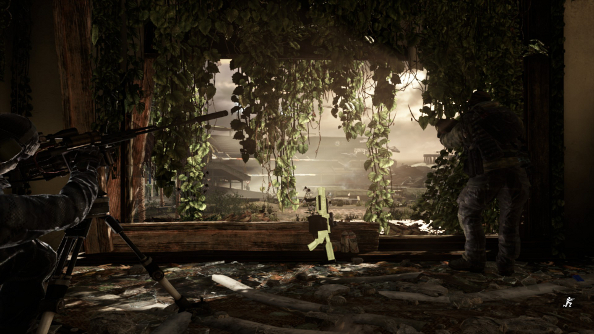
It’s awkward enough that Infinity Ward’s speculative sci-fi tale makes America, once again, the victim of “Johnny Foreigner”, but the developer doesn’t even have the good taste to give the Federation its own voice. Instead, the face of this morally bankrupt evil empire is an ex-Ghost, Rourke, another American, and the people of South America only exist to be shot at and shout the occasional line in Spanish.
The narrative is merely the impetus used to propel the Ghosts all over the world (and above it) to shoot at people in corridors dotted with waist high walls for cover. Most of the five or six hour campaign has players running from point A to B, punctuated with very bland firefights that all blend seamlessly together. It’s like a horrific nightmare, where you’re running down a corridor without an end, shooting without thought, and hoping that the next bullet will put an end to this miserable state of affairs. Sometimes the game tricks you into thinking it’s over, with mission titles such as “End of the Line”, but it’s a horrible lie and it keeps on going.
Spare a thought for the poor enemy soldiers, for they have it even worse. Destined to be nothing but fodder for the dullest of power fantasies, they are simple clones with a death wish. Bred purely to be shot at, their only hope of surviving for more than ten seconds lies in their ability to run back and forth between cover like headless chickens. Perhaps a bullet in the brain pan is actually merciful.
Sometimes the monotony of running in a straight line and shooting mentally subnormal clones is broken up by button prompts. You’ll have to press N or F – but only when you’re told to – and you’ll set an explosive charge or command a remote sniper for a minute, but then it’s back to the mindless march forward towards the credits.
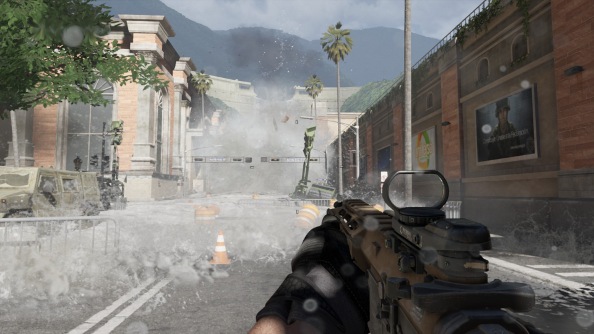
One instance stands out above all others, and left me laughing for a good few minutes. After cutting out the lights in a skyscraper, the Ghosts find themselves in a non descript room, facing a few enemy troops. These foes would be easy to take out normally, but this fight exists to show off a feature that is only used once: the strobe light. Turning on the strobe attachment transforms these battle-hardened soldiers into cowering infants, not just blind, but incapable of doing anything other than weeping. It’s hilarious and nonsensical, and no sooner than the room is cleared, the N button must be pressed again, the strobes switched off, and that’s the last time you’ll ever see these all-powerful flashing lights.
The only thing that got me through the tedium of the campaign were the moments when I could admire the scenery. Infinity Ward has gone all out to craft a title that stands shoulder to shoulder with Hollywood’s big budget action movies. From the Odin orbital weapon dwarfed by Earth below it, to a huge skyscraper crashing to the ground as I parachuted out of it, there are few other developers who can fashion such over the top, breathtaking arenas to fight in.
This does not, unfortunately, translate into fun battles – there aren’t even any opportunities to explore the gorgeous environments. Like the movies Call of Duty: Ghosts apes, there’s nothing interactive about these places, it’s all just window dressing. Huge buildings reveal themselves to be nothing more than straightforward corridors, with doors only being opened if your teammates decide to do it for you, and entire cities are shrunk down into narrow alleyways and a couple of houses. The exception to this is the underwater mission and the two short space missions, since movement is no longer shackled by a two-dimensional plane and there’s more space to move around in. But these fights still amount to moving forward, finding cover, pointing and shooting.
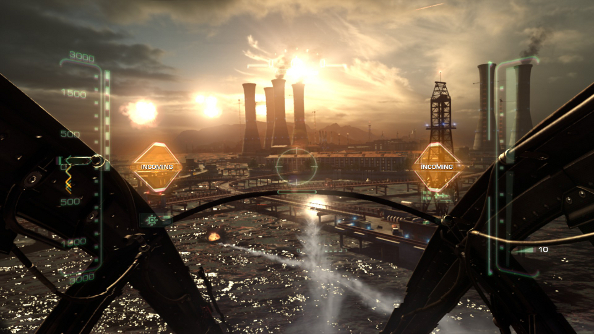
I don’t want to be a complete Debbie Downer in regards to the campaign, so I will admit that I loved Riley, the aforementioned German Shepherd. He’s a completely pointless addition to the game and the occasional stealth sections where he’s employed are laughably bad, where he leaps on enemies, gnashing his teeth, growling, leaving them screaming a shrieking in terror while the fellow just in front doesn’t notice – but he’s lovely. Maybe I just really like dogs, or perhaps it has something to do with the fact that Riley is the only character with a personality.
It’s probably for the best that a significant portion of Call of Duty players don’t give a damn about the single-player element, because there’s absolutely no reason to play it unless you really like German Shepherds. The multiplayer component is what keeps people coming back, year after year, and I can safely say, without a single, solitary doubt that Call of Duty: Ghosts has multiplayer. And it’s alright.
But like the campaign, the multiplayer simply doesn’t do enough to justify its existence when Black Ops II is only a year old, and added so much. The most notable additions are being able to play as a woman and the chance to fight aliens instead of zombies. If you haven’t played the last few installments, however, then you could certainly do a lot worse than while away the hours mowing down fellow players.
There’s no dearth of maps and modes to choose from, like the classics such as good old team deathmatch and arenas taken from the campaign, to the novel Jason Statham-inspired “Cranked” mode, where getting a kill empowers you, but also starts a timer which will result in you exploding if you can’t keep up with the slaughter and mayhem.
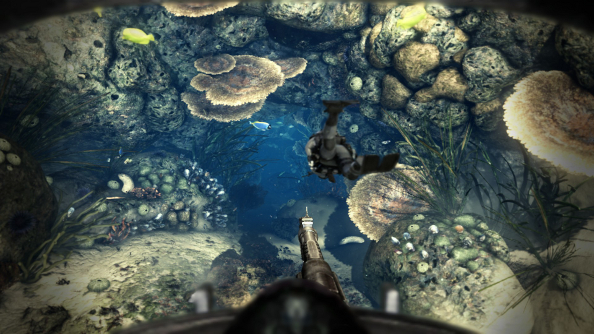
Though Infinity Ward certainly isn’t pushing the envelope, there’s no denying that they know how to make competent, polished online warzones. Even the fairly bland military bases and ruined towns are expertly crafted with countless paths, hiding spots, sniper perches, open kill zones and a significant amount of verticality. At this early stage of the game’s life, there’s a childlike pleasure to be found in exploring these intricate maps and finding the fastest, safest routes to capture points or enemy bases or nasty little spots for the perfect ambush.
Stonehaven is the best of the bunch, at least if – like me – you’re secretly judging the maps by how much you’d like to visit them. There’s some bias with this choice, seeing as that Stonehaven pits the players against each other in rural Scotland, with a crumbling castle at its heart and craggy farmland dotted with cozy crofts surrounding it. Not only would be a nice place to have a picnic (once all the shooty men have buggered off), I probably wouldn’t have to travel far to get there.
Battlefield 4 and Call of Duty: Ghosts might seem like natural competitors, but they are two very different beasts. That said, Activision’s latest has made some moves on EA’s territory: namely by adding some light vehicular combat in the campaign, but more importantly by injecting dynamism into the multiplayer maps which goes head to head with Battlefield 4’s absurdly named levolution feature. Sometimes the effect is pretty drastic, and in Strikezone the Odin orbital cannon from the campaign can be employed to devastate the battlefield, altering the terrain entirely. Initially, causing such devastation is empowering, but – like all the “dynamic” stuff in Ghosts – it’s scripted, changing the map the same way every time.
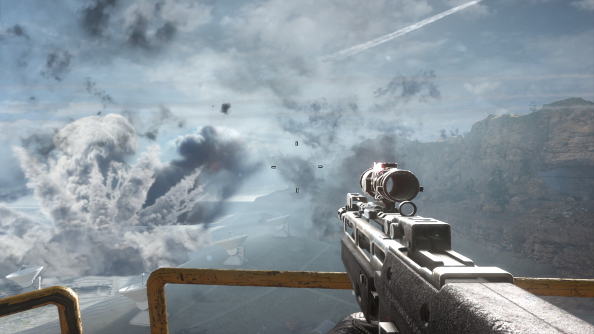
Most changes to the online formula are minor tweaks or call backs to earlier features with a slight twist. Ten custom soldiers can be put together, unlocked with squad points – the currency used to unlock almost everything – and each grunt can be assigned three specific loadouts that harken back to Modern Warfare 3 and can have perks attached to them which provides some eclectic bonuses like improving reload speed or resistance to enemy targeting systems.
Despite providing exactly zero surprises, I did find myself occasionally forgetting how derivative Ghost’s multiplayer was and getting into the spirit of hunting down my enemies and trying not to be quite as terrible as I was when I jumped into my first game. But it’s impossible to shrug off the feeling of “been there, done that” at the end of a match. When other multiplayer games maintain solid player bases for years, it seems absurd to expect players to abandon Black Ops II and splash out on a brand new game that brings so little to the table.
Making this annual franchise nonsense even harder to swallow is Call of Duty’s technical shortcomings. Although it’s a relatively pretty game – if an extremely limited colour palette is your thing – it also has the stink of being a poor port. The optimal video settings option is an outright lie, and it took a fair amount of tweaking to get it running smoothly on a rig that is, according to Activision, well within the recommended system specs (Intel i5-3570K @3.40 GHz, 8 GB of RAM, GeForce GTX 670, and Windows 7 64-bit).
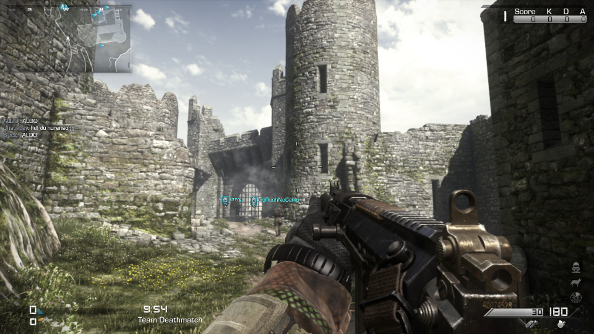
And every time I tweaked the video settings, I’d be shunted back to a checkpoint after having to witness the mission intro video (every single one of which is exhaustingly trite and also prone to stuttering), and I’d just have to hope I wouldn’t have to fiddle around with it again. Even after all this faffing about, my fps would randomly take a nose dive and graphical glitches would rear their ugly heads on average about once a mission.
The big dollop of muck on top of the already cruddy optimisation is buggy mouse controls. Minute corrections like, say, moving the reticle from one enemy to another standing right next to him, frequently causes me to move almost 180 degrees. Despite a slew of supposed “fixes”, I’ve been unable to solve this problem, and it’s just as common in multiplayer as it was during the campaign. In a game where accuracy is key, this is far from a small issue.
Call of Duty: Ghosts offers very few reasons for all but the most obsessed fans to take a look. Most of the time it revels in being mediocre and cowardly by the numbers rather than outright terrible, though there are moments where it manages to be both. If this isn’t a wake up call, showing once and for all that churning out more or less the same stuff year after year only serves to dilute the quality of a franchise, then I don’t know what is. It’s completely shameless, and it’s undoubtedly going to sell phenomenally well.
